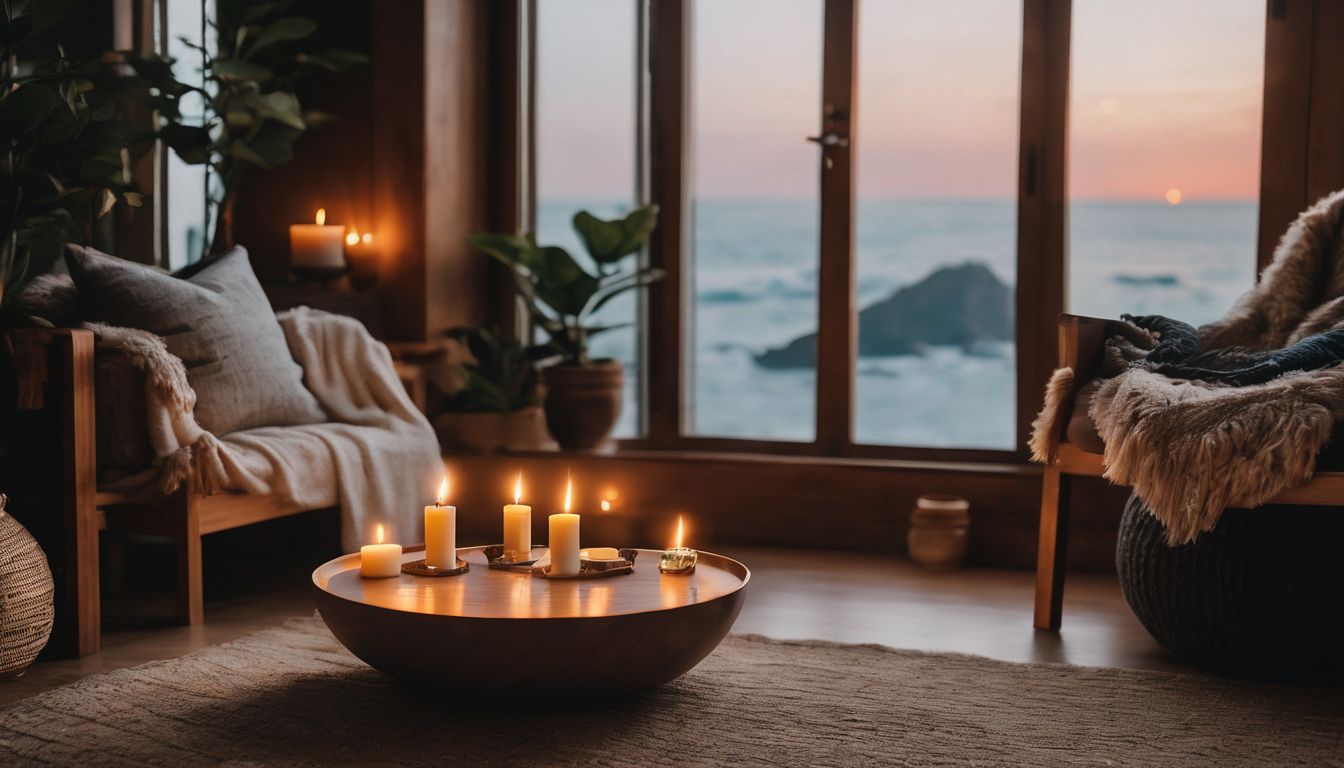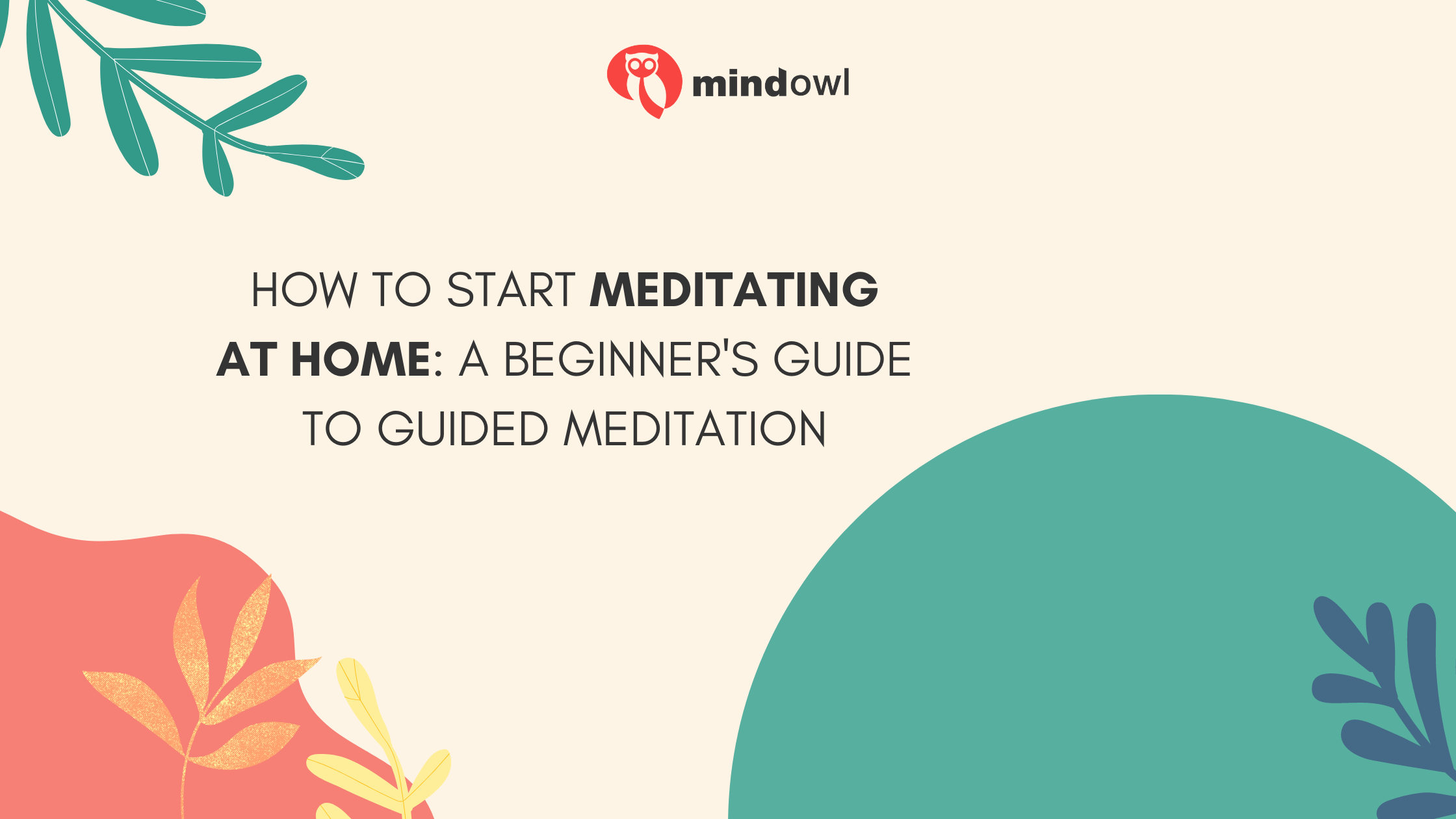The quest for peace in a bustling world often leads us to overlook the sanctuary of our own homes for meditation. Studies have shown that regular meditation practice carries profound benefits for mental health and wellbeing.
Our guide will pave a clear path towards establishing an at-home meditation routine, tailored to comfort and schedule needs. Unwind with ease – let’s begin.
Key Takeaways
- Meditation can lower stress, improve mental health and blood pressure.
- There are many types of meditation like mindfulness and mantra to try at home.
- Creating a special spot at home helps you focus better during meditation.
- Starting with short sessions makes building the habit easier.
- Regular practice is important for getting the most out of meditation.

Benefits of Meditation
Meditation can give you a calm mind and a peaceful heart. It helps your body stay healthy too. When you meditate, stress goes down quickly, which is great for feeling less worried or stressed out.
If you feel anxious or sad, meditation might help with that. It’s good for your mental health. Plus, it can make your blood pressure better and help you deal with feelings in a positive way.
Practicing meditation trains your brain to pay attention and stay steady. You’ll learn how to notice when your thoughts wander away and bring them back calmly without getting upset at yourself.
This makes both your emotions and body stronger.
Overall, meditation is a powerful way to look after both your mind and body. It teaches you how to live in the moment and enjoy life more every day.
What is Meditation?
Meditation is a practice that involves focusing the mind to achieve a state of clarity and relaxation. There are various types of meditation, such as mindfulness meditation, transcendental meditation, and vipassana, each with its own techniques and benefits.
It’s important to find a type of meditation that suits your personal preferences and goals.
Different types of meditation
There are many ways to meditate, each with its unique approach and benefits. Knowing these can help you choose the best fit for your needs.
- Mindfulness Meditation: This involves paying attention to your thoughts as they pass through your mind. You don’t judge or obsess over them; simply observe and take note of any patterns. This practice combines concentration with awareness.
- Concentration Meditation: Here, you focus on a single point. This could be following your breath, repeating a single word or mantra, staring at a candle flame, or counting beads on a mala. When you notice your mind has wandered – in this case, it’s certain – gently bring your focus back.
- Mantra Meditation: Often found in transcendental meditation, this type uses a repetitive sound to clear the mind. It can be a word, phrase, or sound like the popular ‘Om’.
- Guided Meditation: For beginners, guided meditation is especially helpful. A teacher leads you through the process by describing scenes or situations that create a sense of relaxation.
- Meditative Movement: Practices such as yoga combine movement with deep breathing and mental focus to help keep attention sharp and present.
- Loving-kindness Meditation: Also known as Metta meditation, its goal is to cultivate an attitude of love and kindness toward everything – even sources of stress.
- Body Scan Meditation: This type encourages people to scan their bodies for areas of tension. The aim is to notice discomfort without trying to change it.
- Visualisation Meditation: Here you form mental images of places or situations you find relaxing.
- Chakra Meditations: These involve focusing on different energy points in the body where mental blockages are believed to reside.
Why Meditate at Home?
Meditating at home offers the convenience and flexibility to practise on your schedule, in a personalised space that suits your needs. It’s also a cost-effective way to incorporate meditation into your daily routine.
Convenience and flexibility
Meditating at home fits into your schedule whenever you find time. You can pick morning meditation to start your day or evening sessions to unwind. This flexibility means you don’t have to rush to a class or stick to someone else’s timetable.
Your living room, bedroom, or any quiet corner can become the perfect spot for your practice meditation session.
With a personalised space, distractions are fewer and it’s easier to relax. Choosing when and where makes starting meditating at home appealing for many people. Even just a few minutes of meditation tailored around your life can boost focus and cut down on stress without overwhelming your day.
Personalised space
Creating a special area in your home for meditation is key. This space should be quiet, calming and free from distractions. Decorate it with items that make you feel at peace such as cushions, candles or plants.
Your personal touch will help your mind settle down faster.
Make sure this spot is only for meditating. When you sit down here, your brain will know it’s time to calm thoughts and focus on breathing. Stick to this place every day and watch how quickly meditation becomes a habit you love.
Use a meditation cushion to stay comfortable while sitting still for long periods. A soothing environment enhances the sensation of peace during each session.
Cost-effective
Meditating at home saves money. You don’t need to pay for classes or travel to a studio. Studies show that regular meditation can mean big health care savings, from $640 up to $25,500 per person.
It’s free and you can do it in your own space.
Managing stress through meditation may reduce the need for doctor visits. Conditions like high blood pressure, anxiety, and depression often improve with mindfulness practices. This means less spending on treatments and medications over time.
Make meditation a habit and your wallet will thank you too!

How to Meditate at Home
Find a quiet spot in your home where you can sit comfortably and without distractions. Choose a type of meditation that resonates with you, whether it’s mindfulness, breath-focused, or mantra-based.
Start with shorter sessions to build your practice gradually and make sure to meditate regularly for maximum benefits.
Find a quiet spot
Choose a peaceful corner of your home where interruptions are unlikely. This could be your bedroom or any area that feels serene to you. Make sure this space is comfortable and inviting for meditation.
It’s important to have a go-to spot because it sets the stage for a calm experience every time you sit down to meditate.
Ensure this dedicated space is away from daily distractions. A quiet environment helps you focus better during meditation. The less noise, the easier it will be for you to keep your attention on breathing and staying present in the moment.
Your chosen place doesn’t need fancy equipment; just ensure it feels tranquil and welcoming for regular practice.
Choose a type of meditation
Once you have your quiet space ready, picking a meditation style that fits you is next. There are many options like spiritual meditation, mantra meditation, or meditative movements such as yoga.
You might prefer mindfulness meditation where you pay attention to your thoughts without judgement. Or perhaps concentration meditation suits you better; here you focus on a single point like breathing or counting beads.
Another option is guided meditation for beginners: listen to someone’s voice leading you through the process. This can help if focusing alone feels tough. Start with something simple and see what helps calm your mind best.
Remember, trying different forms of meditation teaches us more about how our mind works and what makes us feel at peace.
Start with shorter sessions
Begin your meditation journey with shorter sessions, ranging from five to 15 minutes each day, as recommended by experts. This gradual approach helps in easing into the practice and building a strong foundation for a consistent routine.
Starting off with brief sessions allows you to focus on the technique without feeling overwhelmed, and you can progressively increase the duration over time as you become more comfortable with the process.
By commencing with short meditations, you cultivate a habit that is sustainable and enjoyable, ensuring long-term success in mastering at-home meditation.
Regular practice
Once you’ve established a routine and become comfortable with shorter meditation sessions, the key to mastering at-home meditation lies in regular practice. Consistency is paramount in deepening your meditation experience.
Regular practice fosters a sense of discipline and steadiness, allowing you to harness the full spectrum of benefits that meditation offers. By committing to regular practice, you cultivate resilience and fortitude, enhancing your overall well-being both mentally and physically.
Consistent meditation yields tangible outcomes such as reduced stress levels, improved focus, enhanced emotional regulation, and heightened self-awareness – all contributing to an enriched quality of life.

Meditating at Home vs Meditating with Others
Meditating at home offers convenience and a personalised space, while meditating with others can provide a sense of community and support. Finding a balance between the two can help enhance the meditation experience.
Pros and cons of both
Meditating at home offers convenience and flexibility, allowing for a personalised space to cultivate inner peace. It’s cost-effective and can be easily integrated into daily routines.
However, distractions may arise, and guidance or support might be lacking. On the other hand, meditating with others at a centre provides community and support but involves travel time and potential distractions from fellow practitioners.
Finding a balance between the comfort of home meditation and the support of group practice is crucial. Whether it’s creating an undisturbed space at home or embracing the sense of community in a group setting, both options offer unique advantages that can enhance one’s meditation journey.
Finding a balance
Balancing meditation at home with group sessions offers the best of both worlds. Meditating at home provides convenience and a personalised space, while group meditation fosters community and guidance from experienced practitioners.
It’s essential to find equilibrium between the solitude of personal practice and the shared energy of meditating with others for a well-rounded meditation experience.
Finding this balance enables you to benefit from the flexibility and comfort of practising at home, while also tapping into the support and communal energy that comes with meditating alongside others.
By integrating both approaches, you can enrich your meditation journey and deepen your practice through a blend of individual reflection and collective mindfulness reinforcement. This fusion brings about a more comprehensive understanding of yourself and those around you as part of this transformative process.
Tips for Maintaining a Consistent Meditation Practice
To maintain a consistent meditation practice, set a daily reminder to carve out time for meditation, try different types of meditation to find what works best for you, be kind to yourself when distractions arise, and make it a habit by integrating it into your daily routine.
Developing these habits will help you stay committed and see the benefits of regular meditation practice.
Set a daily reminder
To maintain a consistent daily meditation practice, use your phone to set a repeating alarm or calendar reminder. This simple action can help you stay on track and prioritise your daily meditation session.
By scheduling this reminder, you create a dedicated time for mindfulness in your day, making it easier to integrate into your routine without forgetting about it amidst other tasks and obligations.
Remember to be patient with yourself as you establish this new habit. Setting realistic expectations and showing kindness towards any challenges that may arise will contribute to the sustainability of your meditation practice over time.
Try different types of meditation
Explore different types of meditation to find what suits you best. Experiment with mindfulness meditation, mantra meditation, guided meditation, concentration meditation, or Sudarshan Kriya Yoga Meditation.
Each type offers unique benefits and approaches to help you discover the most effective method for your personal practice. Tailoring your experience will enhance your journey towards wellness and self-discovery.
Discovering various forms of meditation allows you to identify the one that resonates with you while experiencing diverse techniques. Embrace this opportunity to explore new paths in self-care and mental well-being through these different styles of meditative practices – enriching both your understanding and engagement with each session.
Be kind to yourself
Be patient and gentle with yourself as you begin your meditation journey at home. Embrace the moments of struggle or distraction, knowing that it’s okay to experience them. Acknowledge the effort and commitment you bring to your practice, fostering a sense of self-compassion which is essential for building a consistent and rewarding meditation routine.
By practicing self-kindness, you can create an environment that reduces stress, cultivates positivity, and ultimately leads to a more fulfilling experience in your at-home meditation sessions.
Moving on to “How to Meditate at Home”, let’s explore practical steps for establishing a peaceful meditation space within your own home.
Make it a habit
Creating a consistent daily meditation practice is key to reaping the benefits. Begin by setting a specific time and place for your meditation sessions, helping to establish a routine.
Gradually increase the duration of your sessions as you become more comfortable with the practice, reinforcing its integration into your daily life. Making meditation a habit allows you to experience its positive impact on stress reduction, mental clarity, and overall well-being.
By incorporating meditation into your daily routine, you can cultivate resilience and inner peace amidst life’s challenges. Consistency in practice enhances the effectiveness of meditation, providing long-term benefits for both mind and body.
Conclusion
In conclusion, mastering at-home meditation is achievable with commitment and practice. You have learned about the diverse forms of meditation, understood its benefits, and received valuable tips for maintaining a consistent practice.
Remember to create a quiet space, start with shorter sessions, and be kind to yourself as you embark on this transformative journey. With dedication, you can cultivate inner peace and resilience through the art of meditation in the comfort of your own home.
FAQs
1. How do I start meditating at home?
To start meditating at home, find a quiet space where you won’t be disturbed. Choose a meditation technique that suits you, such as focusing on your breath. Sit still and take deep breaths, gently bringing your attention back to the breath if your mind wanders.
2. What is an easy guided meditation for beginners?
An easy guided meditation for beginners involves following simple instructions provided by a meditation teacher or app like Headspace. These guides often include directing focus to the breath and helping bring awareness back when distractions occur.
3. Can meditation help me with my busy mind?
Yes, meditation helps us become more aware of our thoughts without judging them. Every time you notice your mind wandering, simply return your focus to your chosen object of attention—like the breath—and let distracting thoughts go.
4. Is there only one correct way to meditate?
There isn’t just one way to meditate; many forms exist so you can choose what works best for you. Whether it’s sitting in silence first thing in the morning or practicing yoga poses, whatever form of practice brings awareness is beneficial.
5. What part of the day is best for meditating?
The best time to meditate is when it fits into your schedule consistently—first thing in the morning may work well as it sets a calm tone for the day ahead but find a time that allows you making space regularly is key.
6.What are some benefits of regular meditation practice?
Regularly dedicating time to meditate can lead to better sleep and an increased ability to focus and manage stress by training our brain’s amygdala—the part responsible for emotions—to become less reactive over time.
MindOwl Founder – My own struggles in life have led me to this path of understanding the human condition. I graduated with a bachelor’s degree in philosophy before completing a master’s degree in psychology at Regent’s University London. I then completed a postgraduate diploma in philosophical counselling before being trained in ACT (Acceptance and commitment therapy).
I’ve spent the last eight years studying the encounter of meditative practices with modern psychology.

